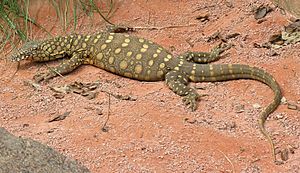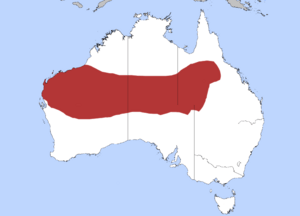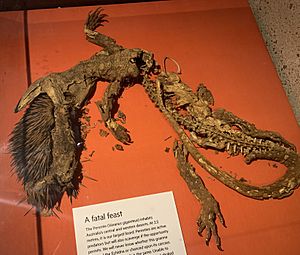Perentie facts for kids
Quick facts for kids Perentie |
|
|---|---|
 |
|
| Perentie at the Dallas Zoo in Dallas, Texas | |
| Conservation status | |
| Scientific classification | |
| Genus: |
Varanus
|
| Species: |
giganteus
|
 |
|
| Distribution of the perentie | |
The perentie (Varanus giganteus) is the biggest monitor lizard in Australia. It is also the fourth-largest living lizard on Earth! Only the Komodo dragon, Asian water monitor, and crocodile monitor are bigger.
You can find perenties in the dry parts of Australia, west of the Great Dividing Range. They are shy and live in remote areas, so people rarely see them. The International Union for the Conservation of Nature says the perentie is a "least-concern species." This means it is not currently in danger of disappearing.
For many Aboriginal cultures, the perentie is very important. It appears in their totem stories and is part of the Ngiṉṯaka dreaming. It was also a favorite food for desert Aboriginal tribes. They used its fat for medicine and special ceremonies.
Contents
What is a Perentie?
The perentie is a type of monitor lizard, also known as a goanna in Australia. It was first described in 1845 by a British zoologist named John Edward Gray. He called it Hydrosaurus giganteus, meaning "gigantic water lizard." Later, it was moved into the group of lizards called Varanus.
Perenties are related to other monitor lizards like the sand goanna and the Argus monitor.
How Big Do Perenties Get?
Perenties can grow very long, up to 2.5 meters (about 8 feet). But most are around 1.7 to 2.0 meters (5.5 to 6.5 feet) long. They can weigh up to 15 kg (33 pounds), and some even weigh over 20 kg (44 pounds).
The crocodile monitor is often longer than the perentie, sometimes over 2.4 meters (8 feet). However, the perentie is usually heavier and more strongly built. Perenties are lean lizards, not as bulky as the Komodo dragon or the Asian water monitor.
Do Perenties Have Venom?
In 2005, some researchers found that monitor lizards might have a mild venom. Before this, people thought that monitor bites got infected because of bacteria. But studies showed that the immediate effects, like swelling and pain, are caused by a mild venom.
Bites from perenties and other monitors can cause swelling quickly. They can also cause pain that shoots up the arm and lasts for several hours. Some scientists believe that these oral secretions play many roles in reptiles, not just quickly catching prey.
Where Do Perenties Live?
Perenties live in the dry desert areas of Western Australia, South Australia, the Northern Territory, and Queensland. They like places with rocky areas and gorges. Their homes often have hard soil and loose stones.
How Do Perenties Behave?
Perenties usually try to avoid people. They often hide or run away before you even see them. They are very good at digging. They can dig a burrow for shelter in just a few minutes. Their long claws also help them climb trees easily.
Sometimes, a perentie will stand on its back legs and tail. This helps it get a better view of what's around. This action is called "tripoding" and many monitor lizards do it. Perenties are also very fast runners. They can run on all four legs or just their back legs.
If a perentie feels threatened, it will defend itself. It uses its sharp claws, teeth, and strong, whip-like tail. It might also puff up its throat and hiss loudly to scare off danger. It can lunge forward with its mouth open as a warning or an attack. A perentie's bite can cause a lot of damage.
What Do Perenties Eat?
Perenties are active meat-eaters. They mostly hunt reptiles and small mammals. Sometimes, they eat birds like diamond doves. They hunt live prey, but they also eat dead animals they find.
Their reptile diet includes other lizards and sometimes snakes. Interestingly, perenties often eat other monitor lizards, such as ridge-tailed monitors and Gould's monitors. They even eat smaller perenties! For example, a 2-meter perentie was seen eating a 1.5-meter perentie. They also eat eastern bearded dragons. Near the coast, they might eat sea turtle eggs and baby turtles.
Mammals they eat include bats, young kangaroos, and small rodents. Young perenties mostly eat insects, especially grasshoppers. Perenties usually swallow their food whole. If the food is too big, they will tear off pieces to eat.
Reproduction
Female perenties lay their eggs either in termite mounds or in the soil.
Gallery
-
A perentie in the Perth Zoo, Western Australia
See also
 In Spanish: Varano gigante australiano para niños
In Spanish: Varano gigante australiano para niños







